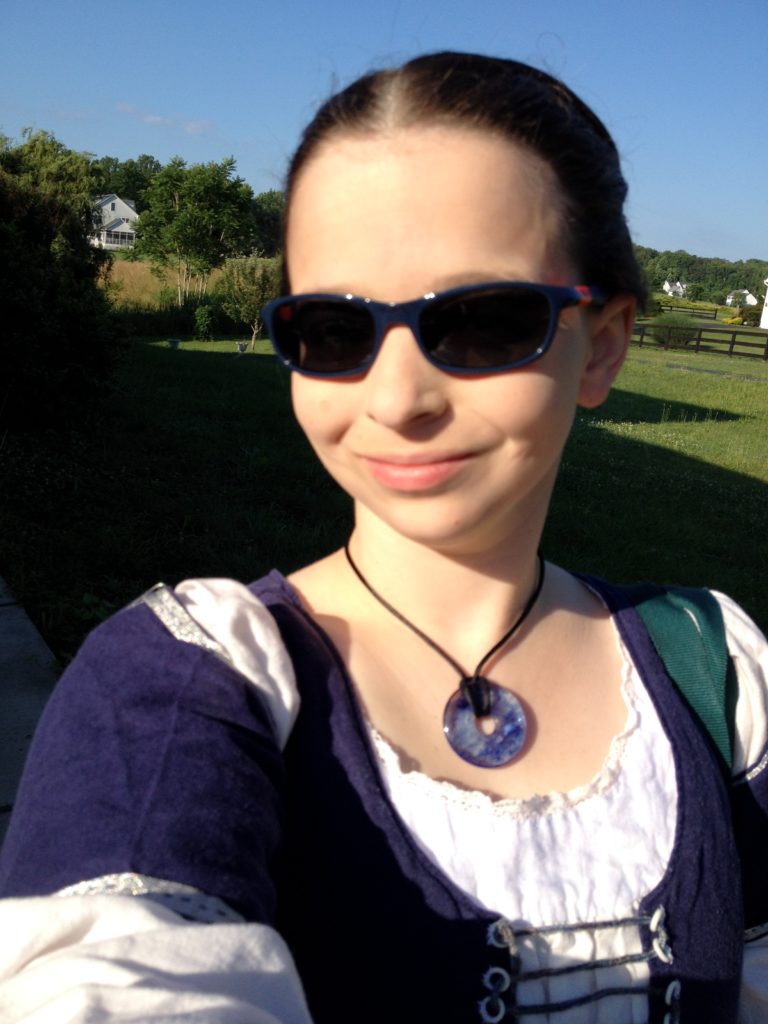Atlantian 12th Night in 2018 was themed around the “Palio di Atlantia” and was generally Renaissance Italy themed. I took this as an opportunity to revisit some of my favorite Italian garments and upgrade them a bit.

Remember this dress? Remember how I hated the sleeves so very much? I decided to make new sleeves as well as an overgarment to go with this. Since I decided that this gamurra looks much more 1480s Florentine than 1500s Venetian, I took my inspiration for the overgarment from appropriate images, in particular Domenico Ghirlandaio’s fresco of the Birth of Mary.

Notice in the image that most of the women are wearing at least three layers – shift (camicia), dress (gamurra), and overdress (cioppa) – some are also wearing a mantello or drape as well. I decided to make a cioppa based on the woman in the middle left, with the green gamurra and the gold-trimmed red cioppa. I wasn’t trying to imitate the colors, just the cut and style, including the gold trim.
There were two main styles of overdress in Florence in the 1480s. The cioppa, seen on most of the women in that fresco had sewn together side and front seams and sleeves. Some had a bodice with a sewn-in skirt, others were all of a piece, similar to the pellando (houpellande) from earlier in the century. The other overdress was the giornea. These were sleeveless, with no side seams and often open fronts as well. There were both men’s and women’s versions of both garments. The giornea was generally considered more appropriate for spring and summer than the cioppa.
I decided to make an unlined cioppa out of sari silk knowing that the event would be indoors in a hotel with the heat no doubt turned up. A fully lined cioppa would have left me too warm to dance, and we can’t have that. I cut off the trim from the sari and then resewed it on at neckline and hem. The trim on the garment in the fresco was probably actually goldwork embroidery.

The pattern was adapted from my existing pattern for a mid-1400s pellando. This turned out to be a mistake, as the wool I had sewn that pellando out of stretches a lot more than silk and the front center seam of this cioppa lays a bit oddly. In future I will probably cut an angled front center seam for the cioppa. I may also need to widen it just under the arm as well.
Construction was mostly simple, sewing the long straight seams of the body together and sewing the sleeves. The sleeves are only attached at the top of the shoulder. The most complicated part was sewing the trim down, since I was taking a straight woven item and forcing it around the curve of the hem and the curve of the neckline. I had to do some interesting miters and darts to make it work.

The new sleeves for the gamurra I made out of the palu of the sari, and I did line those with linen as they needed some body. Very little of the work on that was done by machine, as I ended up completely hand finishing them and doing hand-sewn eyelets so that they would look right to me.

The pattern for the sleeves I took from an existing sleeve pattern. I pinned the muslin on and had a friend draw a circle around my elbow so that I could figure out how to place the cut out for the elbow poof.

All in all this project was a success. There are some bits of fitting that I would do different next time, but I like the garments and they are pretty comfortable to wear. Plus they look great!



I’m amazed, I have to admit. Rarely do I encounter a blog that’s both educative and engaging, and let me tell you, you have hit the nail on the head. The problem is something which too few men and women are speaking intelligently about. I’m very happy that I came across this in my hunt for something relating to this.
I just want to tell you that I’m new to blogging and seriously enjoyed you’re web page. Almost certainly I’m going to bookmark your blog post . You absolutely have fantastic well written articles. Regards for revealing your web site.